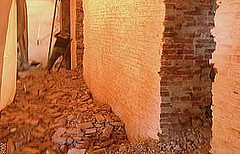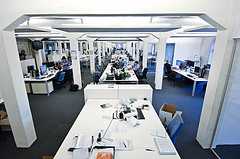
Recently, MediaShift started running reports from “embeds” at various media outlets and educational institutions. This report comes from Roland Legrand, new media director at Mediafin in Belgium.
The company where I work is well-known in Belgium for its print publications. Mediafin is the publisher behind the Dutch language business daily De Tijd and its Francophone counterpart L’Echo. But in recent years, the company’s Internet sites have grown to rival the popularity of its print editions. In July, Mediafin websites reached a new high of an estimated 160,000 unique visitors on one single day, an amount roughly equivalent to the average number of readers per day. But even as online journalism continues to reach more and more readers, journalists themselves continue to balk at putting their work online.
Many are still captivated by the nostalgic charm of the printed page. Others just find that old habits die hard. Mediafin company management has thrown its support behind efforts to bring the newsroom into the modern media age, to encourage print reporters to embrace new media. As head of the Internet and new media editorial staff, I have seen first-hand the changes instituted and have seen what works and what — at least for now — does not.
Mind the Gap
In addition to publishing De Tijd and L’Echo, Mediafin also operates websites for both publications. On a normal working day, the websites draw about 140,000 to 150,000 unique visitors and receive more than 1 million pageviews. Yet despite the growth of online journalism, only 18 out of Mediafin’s 140 journalists work for the electronic media (not including 5 supporting editorial staff members).

De Tijd started experimenting with electronic media in the early 1990s, long before the Internet became available for the general public. In those days, Internet reporting was considered merely a stepping stone, a place for young, inexperienced journalists to start out. The online editorial desks were mainly staffed by junior journalists, who were supposed to learn the tricks of the trade before becoming full-blown journalists doing print reporting.
Today, Internet reporting is still the domain of younger reporters: Those working for wire services and websites are typically in their 20s, while those at the print desks are in their 30s and 40s. But the second-class status of Internet reporters is gradually changing, as the newsroom comes to recognize the importance of new media.
There is still a gap between the print journalists, used to working almost exclusively for the print publications, and their younger colleagues at the electronic desks, who have worked for online as well as for print publications.
Even in the digital age, most journalists remain veritable luddites. Many do not use RSS-feed readers, do not blog, do not use social bookmarks, and have never collaborated using a wiki. They consider tagging to be something best left to supporting staff, have no experience whatsoever using video and audio, and have only the vaguest idea about telepresence techniques such as virtual environments. While the public has been quick to adapt to changing technologies, journalists have lagged behind and now risk losing touch with their readers.
How to Fix the Gap
The Mediafin editorial management team decided to take drastic action. We looked at the technological and physical infrastructure of the newsrooms and found several barriers to the integration of the old and new media departments:
> Physical infrastructure: Our newsroom was divided by brick walls, separating the online desk from the print desks. We are now demolishing the walls, which will hopefully encourage the two sections to interact more! (See the “before” picture of the walls being ripped down above, and the “after” picture below.)

> Technological infrastructure: Currently, we have separate publishing mechanisms for print, Internet, wire, and mobile services. We are looking for a system which integrates all those platforms. For example, an ideal system might automatically prompt a print journalist to write a version of her story for several online publication formats. (If any MediaShift readers have any suggestions, please let me know.)
> We also plan to install a central news management, overlooking online and print publications.
Our journalists were shocked by some of the new policies integrating print and new media — especially the Web First Policy. Print journalists were used to reserving big scoops to first run in the print newspaper; but under the new policy, scoops were to be published immediately on the web. Less controversial was the announcement of courses introducing print journalists to publishing on the web.
Growing Pains: What Works, What Doesn’t
Because we’re still in a learning process, not every experiment has yet been successful. But some innovations have yielded encouraging results.
What works:
> Web First: When publishing scoops on the Net, we contact the major local news wire, making sure that they credit us correctly. Journalists are pleased that their work is being recognized by colleagues and competitors. Recognition by peers is crucial for journalists.
> Living with comments: Journalists get a better idea of their audience when readers are able to comment on the articles. Although our articles get hundreds of reactions each day, we’ve been surprised to find that site users often use the comments feature more to talk amongst themselves than to give feedback to the reporter. But we are learning that one of the most effective ways to manage communities is…by actually joining in the conversation in a polite and friendly way.
> Constituting communities: We started a community of Belgian expats. People of different backgrounds from all over the world post high quality comments here.
> Blogging: Journalists run several blogs now. One blog in particular has been very successful, Bear & Bull (okay, not that original a name!) about financial markets. We have developed a kind of virtual weekly show around the blog, by holding live sessions with special guests and by allowing the community to participate. Other journalists are involved as “correspondents” — for instance, we have a “banking correspondent” who comments on recent financial developments during the live show.
Unfortunately, not everything has gone completely smoothly. There are a few areas where we are still working out the kinks.
What does not (yet) work:
> Social tools (bookmarks, feed readers, sharing sites, professional networks, life-streaming): Our journalists have resisted using new social networking tools, preferring to rely on their old direct contacts. Some have joined Facebook or Linked In, but the professional results are so far disappointing. There are no rational reasons for this choice. I gather that it is simply hard to acquire these new habits. The heavy workload means that experimenting is not self-evident. The newsroom gets the major news wires (Reuters, Bloomberg, etc.), and reporters avoid other sources as information overload. However, electronic networks and virtual environments do serve as an important source of inspiration — something I will discuss in more detail in a future post.
> Acquiring skills: Learning video, audio, HTML/CSS, JavaScript and Flash skills are very difficult because of heavy daily workloads and the fact that specialists already provide everything beyond simple HTML. Even so, I think it would be useful for reporters to acquire a basic knowledge of these media, if only to be able to communicate more effectively with those specialists.
Now the walls have come tumbling down, literally, but there are still walls to break down around learning. Even though it is not easy for all our colleagues to quickly pick up new skills, they are becoming more aware of new possibilities regarding community management and interactivity. I am sure I will have more to tell you about these changes in the coming weeks and months.
Roland Legrand is in charge of Internet and new media at Mediafin, the publisher of leading Belgian business newspapers De Tijd and L’Echo. He studied applied economics and philosophy. After a brief teaching experience, he became a financial journalist working for the Belgian wire service Belga and subsequently for Mediafin. He works in Brussels, and lives in Antwerp with his wife Liesbeth.
Additional editing for this story by Mike Rosen-Molina
Photo of walls being torn down by Frederik Delaplace; photo of unified newsroom by Nima Ferdowsi. You can see a Flickr photostream of the Mediafin construction here.
